If you are looking for some new sources of inspiration, we’d like to introduce you to some distinctive artists, designers, and illustrators – both past and present – that we think ‘you should know.’ Some may be lesser-known while others may seem vaguely familiar, either way you will discover unique talents that might just influence your next project.
This year marks the 75th anniversary of the 1939 cinematic adaptation of The Wizard of Oz. There is hardly a person who has missed seeing the motion picture on television or on the big screen over the years, and despite its age, the film continues to grow in popularity with audiences young and old. Fewer people today are as familiar with the movie’s original source material, the groundbreaking children’s book The Wonderful Wizard of Oz. The book has had countless sequels, assorted re-imaginings and many reissues, complete with new packaging and illustrations, since first being published in 1900. But, it is the original story by L. Frank Baum and the innovative illustrations by W. W. Denslow that first captivated audiences and turned the story into an instant classic. Furthermore, it is the unique work of Denslow that served as the visual framework for the film and as an inspiration to subsequent generations of illustrators and designers.
William Wallace Denslow was born in Philadelphia in 1856. Although primarily self-educated, he did study briefly in New York at both Cooper Union and the National Academy of Design. During his twenties, he began working as an illustrator and artist for various publications as he traveled throughout the country. In the early 1890s he decided to settle in Chicago where he found consistent employment and professional success as a poster artist, book designer, and newspaper illustrator.1
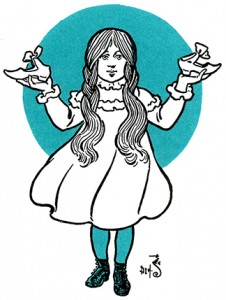
W. W. Denslow and L. Frank Baum were both members of the Chicago Press Club in the late 1800s. After suffering through numerous professional failures, Baum was at the beginning of his future career as a much-beloved author when he met Denslow through the club.2 The two men found a kinship in their respective fields and decided to work together. They first partnered in 1898 when Denslow contributed illustrations to The Show Window, a trade journal about window displays published by Baum. Later that same year, Denslow again worked with Baum, providing two illustrations for his new collection of poetry entitled By the Candelabra’s Glare.3
After establishing a professional rapport, the two men decided to work together on another project, Baum’s newest collection of prose called Father Goose, His Book. Unlike their earlier pairings, this book was truly collaborative as the writing and illustrations were completed in tandem. Denslow would develop imagery inspired by Baum’s verses, while Baum would revise and write new verses to pair with Denslow’s drawings. They also shared the burden of financing the project almost exclusively with their own money. As a result, they retained creative control over the production. With full-color plates and hand lettering, the finished piece was a standout compared to other books in the marketplace. It was first published in late September of 1899, just in time for the Christmas shopping season. The book was an instant success due in large part to the groundbreaking illustrations by Densow, which were completely unique among contemporary children’s literature of the time.4
Following the critical and commercial success of Father Goose, His Book, Baum decided to share with Denslow a completely original idea he had been crafting for many years. In The Wonderful Wizard of Oz, Baum tells the story of a young Kansas farm girl and her faithful little dog, who are transported by a cyclone to a magical land filled with an array of unusual characters. The adventure of Dorothy, Toto, and friends proved to be a challenge to Denslow, stretching his creativity and artistic skill to territories uncharted in the children’s literature of his day.5
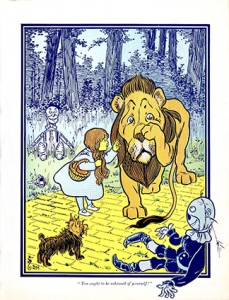
As Denslow stated, “[I had to] work out and invent characters, costumes, and a multitude of other details for which there is no data – and there never can be in original fairy tales.”5
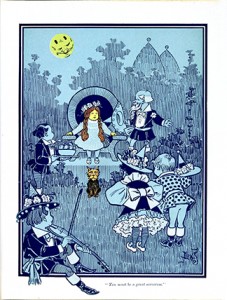
Over the course of the book’s development, he worked tirelessly to design illustrations that would speak to the personalities of each individual that Baum had created. The facial expressions of each character, their clothing, their interactions, and the world they inhabited, came from Denslow’s own imagination and his never-ending dedication to make the piece something special.5
“I experimented with all sorts of straw waistcoats and sheet-iron cravats before I was satisfied,” Denslow explained. “I [also] made twenty-five sketches of those two monkeys before I was satisfied with them.”5
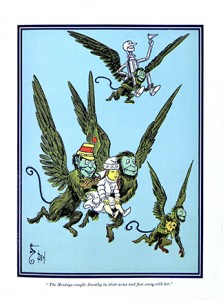
Like their previous partnership, Baum and Denslow largely financed The Wonderful Wizard of Oz with their own money. With each holding a co-copyright for the work, they setout to produce something that was lavish and without equal for the time. The end result was a book with numerous full color plates, colored backgrounds, and illustrations appearing on every few pages. Upon its release in September 1900, again in time for the Christmas season, the book was a run-away hit with readers and critics alike.5
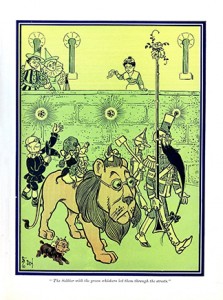
The Grand Rapids Herald wrote in a review that “[the illustrations] are quite as much of the story as in the writing.” The reviewer added, “Dorothy’s wanderings are ingeniously pictured, and as for Dorothy herself and Toto and the Scarecrow and the Cowardly Lion and the Tin Woodman, one would never know exactly what they were like without Mr. Denslow’s aid.”6
Hot off of their acclaimed work, Baum and Denslow next paired their combined talents for the children’s book Dot and Tot of Merryland. Not as lavishly produced as their earlier works, the book was met with mixed reviews and little commercial success.7
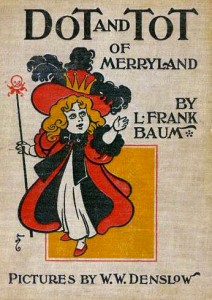
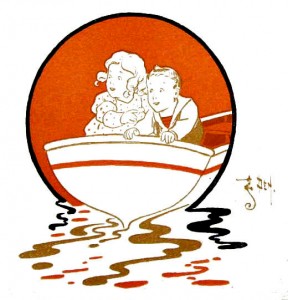
The two men tried to capitalize on the renown of their most popular collaboration by adapting The Wonderful Wizard of Oz into a Broadway musical. During the show’s development, they argued intensely over the financial arrangements of the production. Following these disputes, Baum vowed to never work with Denslow again, thus ending their literary partnership and friendship.1
After their split, Denslow used his fame to launch a solo career. Between 1902 and 1904 he created new illustrations for popular works, retelling them with his own unique visual style. His works included Denslow’s Mother Goose published in 1901, Denslow’s Night Before Christmas published in 1902, and an 18-volume series called Denslow’s Picture Books published between 1903 and 1904. In addition to these works, he used his co-copyright holdings of the Baum books to develop comic strips around Father Goose as well as the Scarecrow and Tin Woodman.1 His last work major was the short-lived comic strip Billy Bounce, which was one of the first comic characters to have a super-power. Drawn to look like a large rubber ball, Billy could bounce high into the air where he appeared to be flying.8
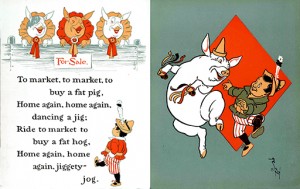
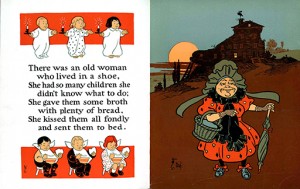
Despite his critical and commercial success, Denslow poorly managed his money, struggled with an addiction to alcohol, and had three failed marriages. In 1915, he sold his last illustration to Life magazine for $250.2 He used that money to binge drink and shortly thereafter contracted pneumonia, dying virtually penniless at the age of 58.9
Regardless of his tragic end, Denslow made a lasting mark on his profession. He also played a pivotal role in the creation of a new literary genre – the American Fairy Tale. Without his contributions, Baum’s groundbreaking work and the subsequent industries around it that followed might have a completely different visual language.
Denslow best summed up his work when he said, “To make children laugh, you must tell them stories of action.” He added, “I tell my stories with pictures, and I can often indicate action by expression. Action and expression, then, are two of my mainstays, and when you add the incongruous, you have the triad that I rely on.”5
1 “William Wallace Denslow.” Wikipedia: The Free Encyclopedia. 1 Apr. 2014. Web. 30 Apr. 2014. http://en.wikipedia.org/wiki/William_Wallace_Denslow